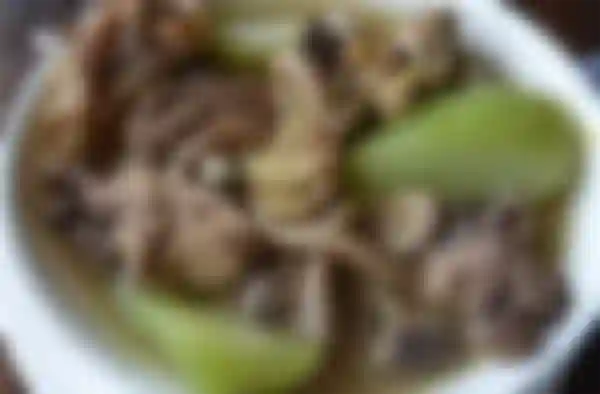I was born and raised on the highlands of the north. Where the evergreens grow, the clear potable rushing rivers tumble, pinewoods scent masks the air, and green and golds of the fields nourished my young mind, body and soul. I was one among those so-called batang 90's or kids of the 90's who in one way or another enjoyed those limb-wringing and bone- twisting games, and grew with the graces my village offers.

These graces include those wild fruits and berries of the mountains, creepy crawlies that coat and cling to river stones. There's lot to mention but my vocabulary is limited and can't put them all into creative writing. However, let me try and carry you through as we traverse the road to my native land.
Highlands of the north, you probably can tell I belong to those indigenous groups of Igorots who is proud of his roots. An ethnic group, like others has a colorful cultures and traditions. But when it comes to foodies, though it is limited only to what is only available in our vicinity. Our ancestors only depend on what they hunt on the mountains, catch on the rivers and their crops. But, it is not the same today when peoples interests expanded as his brothers down the lowlands.
In this article, we'll talk of exotic foods our ancestors lived with. You will find some of these aren't found elsewhere and these are still adapted today as it is already part of us. Some of it are also being served on Igorot cuisines. So let's dig in.
Our native delicacies, Igorot delicacies, I should rather say have simple ingredients with minimal preparation. Most are prepared plain but definitely deliciouso that you can taste the very taste of it.
1. Pinikpikan- Today, it is what Igorot cuisine is known for. Main ingredients are etag/kiniing or inasinan and a native chicken. This chicken is butchered by beating the wings and head with a stick. This is basically to allow the blood coagulate at the wings before giving the head a final blow. The beating is vernacularly called "pikpik", thus the word pinikpikan. But, today some prefer to just slit the neck. Then torched, it gives its distinct taste and aroma than dressing it. It actually was an offering ritual in the olden days.

Together with etag, the prepared chicken is boiled to tenderness and chayote is added. Leafy vegetables are also added if available.
As you can see, it's plain as it is but today we flavor it with ginger and garlic.
This delicacy is often served during occasions and rituals. It is also serve when a relative is visiting from the city to his hometown.
2. Etag/ Kiniing/ Inasinan. This is a pork meat preserved, salted and either dried under the sun or smoked on dirty kitchen. I can still remember my late paternal grandfather's etag. It was not infested with worms. After months of hanging above the fire place to be cured, he wrapped it in a newspaper and keep in a cardboard box above the fireplace. It is literally an Igorot version of ham.

In our village, we call it inasinan. Salted and put inside a jar guvey to preserved. Sometimes it gets infested with worms.
It is not cooked solely but added to pinikpikan, dried white or black beans and other legumes. It can be added to any stir fried veggies or other ways of cooking viand.
3.Saferng/sabeng-It is made of peeled, cooked sweet potatoes or cassava then placed in an earthen jar and covered. Water used to boil these rootcrops are also placed in it. It is allowed to ferment as it is. If used after a week, the taste is not that too sour but the longer it is in the jar the more it gets sour. It is used to cook fish catched from the river or to cook other vegetables. It can also be drank as it is.
Because it is a fermented beverage, it has live microorganisms that helps strengthen the immune system. However,it has a distinctive smell when boiling it to cook the gadiw or vegetables
I have seen my late maternal grandparents put boiled water into the big jar whenever we get some to use in our cooking or whenever someone comes to ask with their container. She also add camote or cassava whenever she see it is necessary especially when they have gathered some in their kaingin.
4. Tapey. It is a rice wine that gets fermented after three short days when the weather is hot and take 5 days when it's cold. It is often prepared during the rice-harvesting season. A perfect beverage to drink for the harvesters because it suits the very hot weather. It can even quenches the thirst of a thirsty god.

Again, I will talk about how my grandparents make perfect ricewine. My late maternal grandmother, used to make the bubud which is used make the glutinous rice ferments. This bubud is what we call yeast which was made from a certain weed roots and pounded with some glutinous rice until it is pulverized. She then adds water to make it sticky and shape into the size of 2" small rice cakes. It will also be fermented before finally drying it under the sun to be preserved.
So when my grandma makes ricewine she put it into two different containers. one is for consumption after fermenting and the other is for keeps. For the wine, she will take out the fermented rice and put it in another tight container. It is left that way for months then it will be used for sigtim( which I will discuss later). The liquid left in the fermentation jar is placed in a bottle (those imported large liqour bottles my grandpa collects). It is kept for a year before it turns to a wine. Some were older, and the older it is the more its taste will be like that of a whiskey. It is what my grandpa served when his sons-in-law visit or his adult grandsons who were working at the city.
5. Sigtim. It is the fermented glutinous rice from number4. It is added to meat or freshwater fish or crab in cooking. Some also add it when making inasinan from number 2.
6. Wildlife delicacies. Yes mountain animal hunting includes wild boars, deers, monitor lizards, wild cats and others which I don't know the names. It is often called herbal or organic.

7.Vato. These were taken from dead rotting woods. They can be either roasted or fried. And gives a distinct aromatic flavor. Well, I did not get to taste it but my grands said it is also has it's own taste. Yummm😋

8.Freshwater fish, crabs, frogs and crawlies. The rivers are aplenty of goby fish (gadiw). It is often cooked with sabeng or sigtim. Sometimes fried. crabs and those crawlies (jayap) are often added on the net used to catched gadiw. It is fried separately or added to the gadiw in sabeng or sigtim.

Those worm like are appun. Extracted from stones on the river. It has coats to protect it from river waters that won't make them carried away. The leaves were also gathered along river banks, it is called paku.

After the planting season, frogs are also aplenty on the rice paddies, thus catched at night. It is often cooked fried or adobo.
9. Hagey/ duom.. When we were kids, this is what we usually longed for during the harvest season. Young, unripe rice grains are left by the older harvesters and the kids gather them. The young grains are then taken from its branch by using using a thin piece of wood then roasted in a big aluminum basin. It is taken out of the fire when it pops then cooled. It is then pounded with a mortar and pestle until the husks were all remove from the grain and cleaned by using a bigao. .
10.Bongsos. Thoroughly washed and salted pork intestines. It is kept for 3-5 days, sigtim can also be added to it when stored..When it is cooked by boiling, it gives off a smell but don't worry it's all part of it because the taste is savory.
11. Avud or dinuguang kanin. It is prepared just like dinuguan but rice is only added to it.

11. Root crops. The Igorots staple food back then when rice was not yet introduced. Number one was the sweet potato. Varieties a long time were really very sweet. Those month old sweet potatoes that are brought home from the fields gets slurry when cooked. It's juice drips from your hands while eating.. Missed those days when they were still plenty.. Due to introduction of different inorganic fertilizers and pesticides that those varieties of sweet potato no longer thrived.

Our forefathers, though with limited knowledge on preparing foods lived with no major health issues. They die of old age..
Wanna dare try any of them?
Reposted from my article 4months ago. All photos used were borrowed from facebook users.
08-01-21
z_graeden










Kamote lang ata na try ko jan .hehe. most of them are fermented ne. gusto ko matry yung pinikpikan at yung version niyo ng ham. hehe